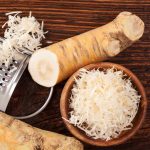Horseradish contains powerful cancer-fighting compounds, according to NEW research
 (NaturalHealth365) Horseradish is a key flavor in prepared foods such as potato salad, sandwiches, and sauces. It can also add zest to dips and vegetable dishes. However, new research has found that eating horseradish can help inhibit cancer cell growth.
(NaturalHealth365) Horseradish is a key flavor in prepared foods such as potato salad, sandwiches, and sauces. It can also add zest to dips and vegetable dishes. However, new research has found that eating horseradish can help inhibit cancer cell growth.
How does it work? Glucosinolates, which are abundant in horseradish, hydrolyze to produce sulforaphane (SFN), a compound with significant preventive and therapeutic effects on various human cancers through mechanisms such as scavenging oxygen radicals, inducing apoptotic pathways, inhibiting cell cycle progression, and suppressing tumor stem cells. Glucosinolates assist the body in detoxifying – at the cellular level – and eliminating harmful free radicals.
Horseradish: A potent cancer-fighting ally
While broccoli (which is in the same family as horseradish) is known for its glucosinolate content, horseradish has 10 times the amount. Horseradish is pretty pungent, so (fortunately) a little goes a long way both in terms of flavor and cancer-fighting benefits.
In one study, the research team looked at 11 horseradish strains, including U.S. No. 1, No. 2, and Fancy. (These designations are based on the length and diameter of the horseradish root.)
Horseradish can fight cancer well due to its detoxification ability and high absorption rate; around 90 percent of this compound is effectively absorbed after ingestion.
Now, for the history lesson: Horseradish is native to western Asia and southeastern Europe but is also grown in the temperate parts of North and South America, Africa, and New Zealand. It is rich in phytochemicals, especially glucosinolates, which give horseradish its signature pungent flavor.
In fact, it can contain up to eight different types of glucosinolates.
Horseradish has a long history of medicinal use
Once in the body, glucosinolates are broken down into powerful derivatives called indoles and isothiocyanates – which help us avoid cancer cell growth. In addition to its cancer-fighting properties, horseradish contains key nutrients like calcium, phosphorous, potassium, magnesium, and vitamin C.
Horseradish root is most commonly ground into a spice and prepared as a condiment. However, it has also been used medicinally for over 3,000 years.
For example, the ancient Romans and Greeks used it to ease muscle pain, and it was taken internally for cramps and coughs. It is even said to have properties as an aphrodisiac.
However, by around the 16th century, it began to be used in cooking and blended into condiments and sauces.
Since then, horseradish has been used to treat asthma, colds, toothache, colic, and scurvy (because of its vitamin C content.) Horseradish poultices relieve pain through topical application, and it has even been infused into milk for use in skin care.
Harness horseradish’s potential by fighting cancer with flavor
Recent research confirming the cancer-fighting properties of horseradish suggests exciting possibilities. Its glucosinolates could be extracted and concentrated into supplements or medications to help prevent and slow the growth of cancer cells.
In the meantime, try adding more organic horseradish to your diet by mixing it into salad dressings, using it as a zesty topping for sandwiches, stirring it into vegetables, adding it to marinades for 100% grass fed meats, or blending it into dips and sauces. Remember, living a healthy lifestyle is always worth the effort.
Sources for this article include:



